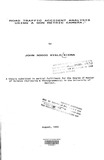| dc.description.abstract | The road traffic accident (RTA) situation in Kenya is, to say the least, simply appalling. Accordingly, the RTA analysis methodology used is not only inefficient and inaccurate, but is also susceptible to criminal distortion. This thesis set out to investigate into the RTA analysis locally practiced while seeking to establish a low investment and operational cost, albeit speedy, photogrammetric method that could be used for the same purpose. This would also preferably provide a permanent record that may be admissible in the courts of law.
The Departmental non-metric (Mamiya C3) camera was identified and adopted as a low cost data acquisition tool. As is the requirement in non-metric photogrammetry, an elaborate data reduction scheme was required. The Direct Linear Transformation (DLT) approach was used in this respect. To this the two DLT restrictions were added.
Data was collected from various diverse sources. Several trips were made in the company of traffic police officers to different RTA scenes. The type, nature and rigour of observations and measurements made by these officers was carefully noted. An inventory was also later made into the po 1 ice RT A f i 1 es. Photog r aphs of var i ous " 1 i v e: and "simulated' RTA scenes were also taken. The required .photocoordinates were then made from a Zeiss Stereocord and
on the Wild A8 stereo-plotter for comparison purposes. Relevant data was analyzed on the Vax 6310 mainframe computer located at University of Nairobi.
It was established that an RTA'plan of scale 1/100 or even larger. was easily accomplished under the proposed
methodology using either of the above comparators. Also, different perspective views of any RTA scene were possible. This methodology on the average, reduced the time required at the RTA scene by at least ten minutes.
The results from this thesis tend to strongly suggest that an RTA analysis methodology akin to the one proposed should be used henceforth. This would not only change the old technology to a new one in local RTA analysis strategies, but also improve the collection, accuracy, preservation and presentation of metric RTA data. Further, this would also add a new dimension into understanding how RTAs occur and how to handle them properly; something that is long overdue in Kenya. | en |

